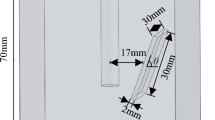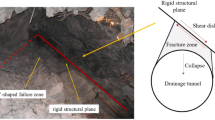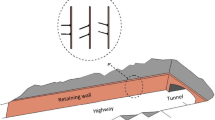Abstract
In practical engineering, due to the noncontinuity characteristics of joints in rock slopes, in addition to plane failure, stepped sliding failure may occur for intermittently jointed rock slopes. Especially for intermittently bedding jointed rock slopes, the correlation and difference in strength parameters between joints and rock bridges, along with the various failure modes and intermittency of rock bridges, contribute to the complexity of stepped failure modes and the unpredictability of failure regions. Based on the upper-bound limit analysis method and multi-sliders step-path failure mode, considering the shear and tensile failure of rock bridges and the weakened relationship between the strength parameters of rock bridges and jointed surfaces, by introducing the modified M-C failure criterion and the formula for calculating the energy consumption of tensile failure of rock bridges, two failure mechanisms are constructed to obtain the safety factor (Fs) of intermittently jointed rock slopes. The sequential quadratic programming method is used to obtain the optimal upper-bound solution for Fs. The influence of multiple key parameters (slope height H, horizontal distance L, Slope angle β, shear strength parameters of the rock bridge φr and cr, Dimensionless parameter u, weakening coefficients of the internal friction angle and cohesion between the rock bridges and joint surfaces Kφ and Kc) on the stability analysis of intermittently jointed rock slopes under the shear failure mode of rock bridges as well as under the tensile failure mode is also explored. The reliability of the failure mechanisms is verified by comparative analysis with theoretical results, numerical results, and landslide cases, and the variation rules of Fs with each key parameter are obtained. The results show that Fs varies linearly with φr and cr of the rock bridge and with Kφ and Kc, whereas Fs changes nonlinearly with H and L. In particular, with the increase in Kφ and Kc, Fs increases by approximately 52.78% and 171.02% on average, respectively. For rock bridge tensile failure, Fs shows a nonlinearly positive correlation with φr, cr, Kφ and Kc. In particular, with the increase in Kφ and Kc, Fs increases by approximately 13% and 61.69% on average, respectively. Fs decreases rapidly with increasing slope gradient β and decreasing dimensionless parameter μ. When Kφ and Kc are both less than 1.0, the stepped sliding surface occurs more easily than the plane failure surface, especially in the case of tensile failure of the rock bridge. In addition, rock slopes with higher strength parameters, taller heights, and greater weakening coefficients are prone to rock bridge tension failure with lower Fs, and more attention should be given to the occurrence of such accidents in actual engineering.
Similar content being viewed by others
Availability of Data/Materials: Data or Materials will be made available on request from the Corresponding author.
Change history
08 April 2024
An Erratum to this paper has been published: https://doi.org/10.1007/s11629-024-8648-2
Abbreviations
- Abb.:
-
Explanation
- α :
-
The angle between the slope top and the horizontal plane
- α i :
-
The angle between the sliders at point O
- BB1 :
-
The tensile fracture
- B1B2 :
-
The upper joint surface
- B2B3 :
-
Rock bridge
- B3B4 :
-
The lower joint surface
- β :
-
Slope angle
- β i :
-
The angle between the slip surface and the horizontal plane
- C :
-
The difference between the angles of adjacent joint surfaces
- D c :
-
The internal dissipation rate
- F s :
-
The safety factor
- f t’:
-
Uniaxial tensile strength
- H :
-
The slope height
- K φ, K c :
-
The weakening coefficients of the internal friction angle and cohesion between the rock bridges and joint surfaces, respectively, and their values range from 0 to 1
- k Y :
-
The fracture connectivity rate.
- L :
-
The horizontal length from the tensile fracture to the top point of the slope
- γ :
-
Bulk density
- S i :
-
The slider area
- μ :
-
Dimensionless parameter (indicates the contribution of tensile strength truncation)
- u i :
-
Slider absolute speed
- u r(i) :
-
Slider relative speed
- W e :
-
The external dissipation rate
- φ j, c j :
-
Shear strength parameters of the joint surface
- φ r, c r :
-
Shear strength parameters of the rock bridge
- δ i :
-
The angle between the sliders at point Bi
- σ s :
-
The ground overload (kpa)
- η :
-
The angle (φr < η < 90°) between the rock bridge and the absolute speed when the rock bridge fails in tensile failure
References
Brideau MA, Yan M, Stead D (2009) The role of tectonic damage and brittle rock fracture in the development of large rock slope failures. Geomorphology 103(1):30–49. https://doi.org/10.1016/j.geomorph.2008.04.010
Cen DF, Huang D, Huang RQ (2013) Step-path failure mode and stability calculation of jointed rock slopes. Chin J Geotech Eng 36(4):695–706. https://doi.org/10.11779/CJGE201404014
Chen ZQ, Wang LQ, Liu SC (2013) Study on the ultimate dip Angle of plane sliding surface of rock slope. Yangtze River, 44(13):39–42. https://doi.org/10.16232/j.cnki.1001-4179.2013.13.006 (In-Chinese)
Einstein HH, Veneziano D, Baecher GB, et al. (1983) The effect of discontinuity persistence on rock slope stability. Int J Rock Mech Min Sci 20(5):227–236. https://doi.org/10.1016/0148-9062(83)90003-7
Eberhardt E, Stead D, Coggan JS (2004) Numerical analysis of initiation and progressive failure in natural rock slopes — the 1991 Randa rockslide. Int J Rock Mech Min Sci 41(1):69–87. https://doi.org/10.1016/S1365-1609(03)00076-5
García M, Pastén C, Sepúlveda SA, et al. (2018) Dynamic numerical investigation of a stepped-planar rockslide in the Central Andes, Chile. Eng Geol 237:64–75. https://doi.org/10.1016/j.enggeo.2018.02.001
Hoek E, Bray JW (1977) Rock slope engineering, 2nd edn. Institution of Mining and Metallurgy, London, UK.
Huang RQ, Xu Q (2008) Typical catastrophic landslide in China. Science Press, China.
Huang D, Cen DF, Ma GW. et al. (2015) Step-path failure of rock slopes with intermittent joints. Landslides 12(5):911–926. https://doi.org/10.1007/s10346-014-0517-6
Jennings JE (1970) A mathematical theory for the calculation of the stability of slopes in open cast mine. Proceeding of the Symposium on the Planning Open Pit Mines. Johannesburg. pp 87–102.
Li DJ, Jia WT, Cheng X, et al. (2022a) Limit state analysis of stepped sliding of jointed rock slope based on tensile-shear composite failure mode of rock bridges. Bull Eng Geol Environ 81(6):1–11. https://doi.org/10.1007/S10064-022-02731-X
Li DJ, Jia WT, Zhao LH, Cheng X, et al. (2022b) Upper-Bound Limit Analysis of Rock Slope Stability with Tensile Strength Cutoff Based on the Optimization Strategy of Dividing the Tension Zone and Shear Zone. Int J Geomech 22(5):1–11. https://doi.org/10.1061/(ASCE)GM.1943-5622.0002366
Li TZ, Yang XL (2019) Three-dimensional face stability of shallow-buried tunnels with tensile strength cut-off. Comput Geotech 110:82–93. 110:82-93.10.1016/j.compgeo.2019.02.014
Liu HZ (2018) Dominant mechanism of planar fracture and rock failure. Chengdu: Sichuan University.
Michalowski RL (2017a) Failure potential of infinite slopes in bonded soils with tensile strength cut-off. Can Geotech J 55(4):477–485. https://doi.org/10.1139/cgj-2017-0041
Michalowski RL (2017b) Stability of intact slopes with tensile strength cut-off. Géotechnique 67(8):720–727. https://doi.org/10.1680/jgeot.16.P.037
Oppikofer T, Jaboyedoff M, Blikra L, et al. (2009) Characterization and monitoring of the Åknes rockslide using terrestrial laser scanning. Nat Hazards Earth Syst Sci 9(3):1003–1019. https://doi.org/10.5194/nhess-9-1003-2009
Park D, Wang Z, Michalowski RL (2017) Consequences of seismic excitation on slopes in soils with a tensile strength cutoff. Geotech Front 304–313. https://doi.org/10.1061/9780784480458.030
Park D, Michalowski RL (2017) Three-dimensional stability analysis of slopes in hard soil/soft rock with tensile strength cut-off. Eng Geol 229:73–84. https://doi.org/10.1016/j.enggeo.2017.09.018
Park D, Michalowski RL (2018) A cone surface in three-dimensional analyses of slopes with tension cut-off. Geotech Res 5(2):51–67. https://doi.org/10.1680/jgere.18.00003
Sturzenegger M, Stead D (2012) The Palliser Rockslide, Canadian Rocky Mountains: Characterization and modeling of a stepped failure surface. Geomorphology 138(1):145–161. https://doi.org/10.1016/j.geomorph.2011.09.001
Tannant DD, Giordan D, Morgenroth J (2017) Characterization and analysis of a translational rockslide on a stepped-planar slip surface. Eng Geol 220:144–151. https://doi.org/10.1016/j.enggeo.2017.02.004
Wang GL, Wu FQ, Zhang MS (2011) Method of Upper Bound Limit Analysis for Plane Sliding of Rock Slopes. J Eng Geol Env 19(2):176–180. https://doi.org/10.1088/0253-6102/55/2/31 (In-Chinese)
Xu Q, Chen JJ, Feng WK, et al. (2009) Study of the Seismic Response of Slopes by Physical Modeling. J Sichuan Univ, Eng Sci Ed 41(03):266–272. https://doi.org/10.15961/j.jsuese.2009.03.009 (In-Chinese)
Xu Q, Dong XJ (2011) Genetic Types of Large-Scale Landslides Induced by Wenchuan Earthquake. J China Univ Geosci 36(06):1134–1142. https://doi.org/10.3799/dqkx.2011.119 (In-Chinese)
Yi ZJ, Huang RQ, Wu HY, et al. (2016) Research on Formation Mechanism of Tanggudong Landslide. J Eng Geol 24(6):1072–1079. https://doi.org/10.13544/j.cnki.jeg.2016.06.005 (In-Chinese)
Zhang SH, Gao WX, Yan L, et al. (2020). The characteristics of blasting vibration frequency bands in jointed rock mass slope. Environ Earth Sci 79(23). https://doi.org/10.1007/s12665-020-09267-x
Zhao LH, Li DJ, Tan HH, et al. (2019) Characteristics of failure area and failure mechanism of bedding rockslide in Libo County, Guizhou, China. Landslides 16(7):1367–1374. 1367-1374.10.1007/s10346-019-01188-6
Zhu L, Huang RQ, Yan M, et al. (2017) Step-path failure mechanism of rock slopes based on crack coalescence modes in rock mass. Chin J Geotech Eng 39(7):1216–1224. https://doi.org/10.11779/CJGE201707007 (In-Chinese)
Zou ZX. (2014) Research on the Evolution Dynamics of the Consequent Bedding Rockslides. Doctoral Dissertation. Wuhan: China University of Geosciences.
Zuo S, Hu CW, Zhao LH, et al. (2020) Barton-Bandis Criterion-Based System Reliability Analysis of Rock Slopes. J Cent South Univ 27(7):2123–2133. https://doi.org/10.1007/s11771-020-4435-6
Zuo S, Hu CW, Zhao LH, et al. (2021a) Reliability back analysis of a 3D wedge slope based on the nonlinear Barton-Bandis failure criterion. Eng Fail Anal 128:105601. https://doi.org/10.1016/j.engfailanal.2021.105601
Zuo S, Zhao LH, Tan HH, et al. (2021b) Reliability parameters back analysis of bedding rock slope with multiple slide surfaces. Bull Eng Geol Environ 80(9):1–13. https://doi.org/10.1007/s10064-021-02355-7
Acknowledgements
This study was financially supported by the National Natural Science Foundation of China (Nos. 52208369, 52309138, 52209142, 51978666), the Department of Science and Technology of Sichuan Province (2023NSFSC0284). All financial supports are greatly appreciated.
Author information
Authors and Affiliations
Contributions
LI Dejian: Conceptualization, Software, Validation, Writing-original draft, Writing-review & editing, Resources. FU Junwen: Conceptualization, Software, Investigation, Validation, Writing-original draft. LI Hekai: Investigation, Formal analysis, Validation, Writing-original draft. CHENG Xiao: Formal analysis, Validation, Writing-original draft. ZHAO Lianheng: Conceptualization, Resources, Writing-review & editing. ZHANG Yingbin and PENG Xinyan: Resources, Writing-review & editing.
Corresponding authors
Ethics declarations
Conflict of Interest: The authors declare no conflict of interest.
Rights and permissions
About this article
Cite this article
Li, D., Fu, J., Li, H. et al. Stability analysis of intermittently jointed rock slopes based on the stepped failure mode. J. Mt. Sci. 21, 1019–1035 (2024). https://doi.org/10.1007/s11629-023-8192-5
Received:
Revised:
Accepted:
Published:
Issue Date:
DOI: https://doi.org/10.1007/s11629-023-8192-5




